
By Elizabeth Nagle, excerpted from Veterans of the
Road,
Ms. Nagle's 1955 history of the Veteran Car Club.
|
| |
|
|
When
Henry Cornelius announced his intention of making a film
depicting a fictitious Brighton Run, and asked the club to help, it was
never imagined that a unique page in the club's history was
about to be written, a page that would forever be part of the
permanent pattern, and yet one which told a story apart from the
rest. It is a story of fun and frolic tempered with caution, of patience
and forbearance mixed with trepidation, of laughter, excitement,
tumult and hard work. |
|
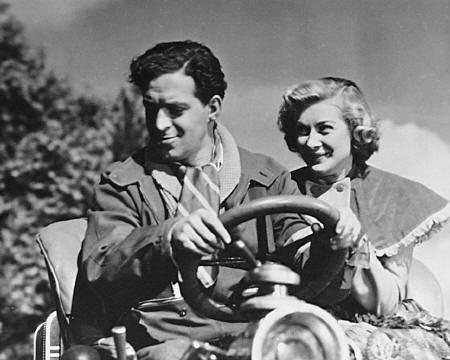 |
In the beginning, there were two factions: Mr.
Cornelius knew what he wanted: he had his script and
his stars; he needed advice and cars. The committee,
on the other hand, knew what it did not want: the
wrong sort of film showing a mockery of the run. But it
had the cars. It had, too, its own ideas of the demands that film
directors were inclined to make, while Mr. Cornelius had more
than a faint notion of how to get his own way. "Read the script,"
he said. "We want your help, your cars and your blessing." In
the end, he got all three and before very long, goodwill was added
for full measure. |
|
The first reading of the script brought cries of alarm: "You
can't do that, or that or THAT! and who has ever heard of an
ancient Lanchester with a bonnet ?" "That's precisely where you
come in," was the patient reply. "Authenticity is what we want,
and only you can give it." There was much anxiety on that race
back, for was it not the very antithesis of the club's objects? A
series of meetings began and gradually these heart-burnings were
eliminated. Steadily, too, a mutual trust disposed of the problems
and brought about a partnership which worked smoothly and well.
On the club side, a great deal of the credit for this belongs to
Evelyn Mawer. He became the club's representative, Mr. Cornelius'
technical adviser-in-chief and the Secretary's prop and stay, to say
nothing of his own and his car's appearances on the set. |
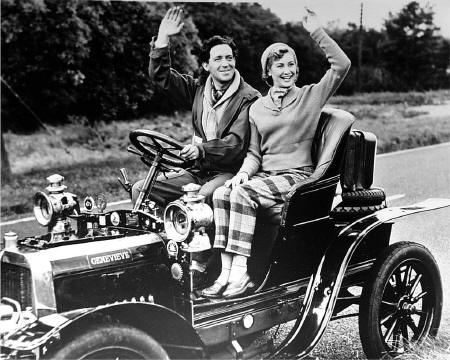 |
| |
|
|
In theory, it seemed a
simple matter for the club to produce two
cars for three months, thirty-five on one day in Hyde Park, ten
here, fifteen there and twenty in Brighton. In practice, it assumed
the proportions of a military operation. Members had to be invited
to take part; they had to know dates, but these depended on the
weather; they had to know places, but many of these were uncertain;
they had to know duration of shooting, but that was controlled
by the sun. Above all, the choice of "Genevieve" herself and her
chief rival was the major problem. The shooting of the film was to
continue from September to November, so that these two cars
would be away from their owners for the vital months of preparation
for the Brighton Run. The risk of damage, too, was great; it had
been suffered before in film work, and many
members, although prepared to drive their cars
themselves for shooting, were not willing to hand them
over to a doubtful fate. |
| |
|
| Henry Cornelius had set his heart on a
Lanchester for Claverhouse's car, but all his charm and persuasion were of no
avail. The gears of the early Lanchesters are too
intricate for inexperienced
fingers ; their owners spoke with one voice, and the united answer
was "No." Both the club and the Director were keen to feature a
British-made car; a Wolseley and then a Humber was proposed for
"Genevieve" but there were none available for the task. Finally,
Norman Reeves and Frank Reece came to the rescue: the former's
1904 Darracq was cast to play "Genevieve" and the latter's Spyker,
the only Dutch car in the club, made a superb adversary. Better
still, a member of Mr. Reeves' staff, Charlie Cadby, himself a
member of the club, became the star cars' keeper for the duration
of the filming, and it was thanks to him that they were still running
at the end of it. |
| |
|
|
 |
The chief contestants settled, the
H.Q. telephone progressed from very warm to red hot.
Thirty-five Veterans in Hyde Park on a weekday was no
small undertaking, and not just any Veterans would do;
they had to be beautiful, burnished and brightly
coloured; some of them had to be available for continuation shots
and their drivers had to be prepared for anything. That was the
easiest qualification; it is part of a member's make-up. Owners
pointed out with polite firmness that they did work, that short
notice was impossible (a fact that the Secretary knew only too well),
and that getting wet on a real "Brighton" was
one thing BUT. ... Finally, all was
resolved, members turned up trumps as they always
did, and thirty-five impeccable Veterans joined the directors,
technicians, pantechnicons, cameras, arc lamps and stars beside
the Serpentine in Hyde Park. The adventure had begun. |
| |
|
| All those who have seen the film know what
followed, but what they did not see was the turmoil
and seeming confusion; the starting and stopping, the
endless waiting; the driving to and fro, the standing
and looking, the watching and wondering. The queue for
coffee and the lunch under the trees; the orders, counter-orders
and the constant repetition; the grumbles and humour, the sudden
laughter. Dinah Sheridan doing her knitting, Kay Kendall struggling
with Suzy, John Gregson struggling harder with "Genevieve" and
Kenneth More handling the Spyker with surprising skill. Master
of it all was Henry Cornelius, patient,
imperturbable and persuasive. |
| |
|
|
From Hyde Park the scene shifted to the Mall,
Constitution Hill, Westminster Bridge, all the old
familiar landmarks of the Brighton Run. The cars got
mixed up with the Life Guards, a Buckingham Palace
sentry and incredulous onlookers who stood and stared.
There was one glorious day in Brighton with brilliant sun and blue
skies and Madeira Drive looking as it never will in November .
There were the twos and threes who carried out their orders in
divers places, the faithful who turned out anywhere at any time
and lastly, the grand finale in the studios. |
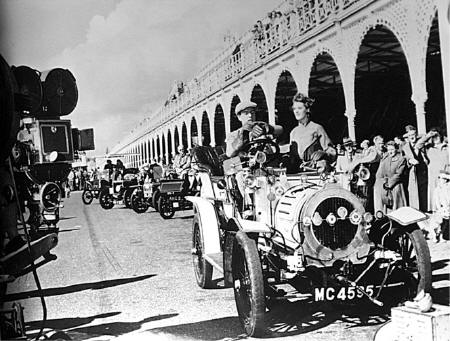
What's wrong with this picture?
|
| Not once was shooting delayed by the absence of
a car; not once did a breakdown spoil a sequence. By
the time it was all over,
thirty-nine members and their cars had achieved between them a
total of ninety-five appearances, and apart from the Darracq and
the Spyker, the driving throughout had been done by the owners,
who accustomed themselves to a quaint situation with a speed
which was astonishing. If any doubts had existed of the goodwill of
the club or the reliability of its cars, they were dispelled with
alacrity, and if members had doubted the capacity of film directors
for hard work, understanding and humour, their fears foundered
on the first day. |
| |
|
| The outside shots requiring the cars were
completed by the end of October, but Mr. Cornelius was
quick to realise that the thirty-five in Hyde Park
with a few hundred onlookers hardly did justice to a
real "Brighton" entry surrounded by thousands of spectators. Consequently, the
start of the "live" run on November 2nd, 1952, was
filmed, and despite the bad weather, the pictures that were obtained
add much to the authenticity of the film, and immortalise a scene
which has become a traditional part of London's November
pattern. Mr. and Mrs. Cornelius had attended the club's cocktail
party the evening before, and were in action early the next morning,
anxious to absorb that atmosphere of its own which only the real
thing could give them. |
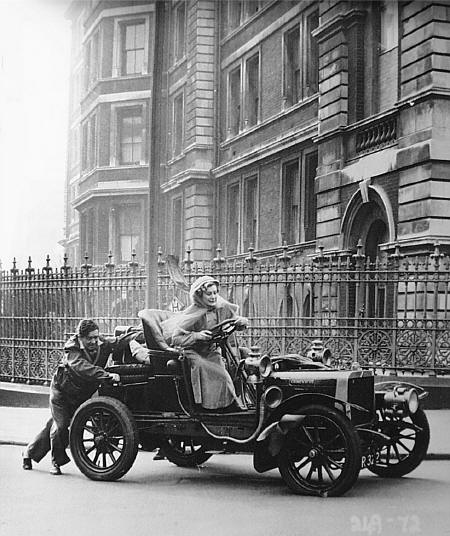 |
| |
|
| For the next six months, the club had little to
do but wait and wonder. By Christmas, the Darracq and
the Spyker were home again and the task of restoring
them to their former fitness begun. In the spring,
plans were laid for the club's share in the premiere and the
Rank Organisation's co-operation with the Coronation Rally which
coincided with the opening showing of the film in London. As the
weeks went by, speculation on the picture grew. Rumours from the
studios were few and guarded, and the Director refused to be drawn.
"Just wait and see," he said-an expression which had been found
to be his favourite months before. |
| |
|
| At last, May 27th became a
reality, and all the members who had taken part, and were able to
accept the Rank Organisation's invitation to attend, turned up in
force to see what had been done with their contributions, over which
they had, after all, exercised only remote control. Harry Browell,
who, as chairman of the committee, had done much to found the
happy partnership between the club and Mr. Cornelius, was
appointed the V.C.C. critic, and in his own inimitable fashion this is
what he wrote: |
| |
|
On May 27th at the Leicester Square Theatre the first showing took
place of the film with which many members
were so energetically concerned. All the suitable
circumstances of a premiere had been laid on and
bouquets offered and accepted and nice things said and
reciprocated.
Before many feet of film had passed it
became clear that the V.C.C. were not the only
ones to exert themselves and that Henry Cornelius
and his cheerful team had made a film that may be shortly described
as very, very good indeed. ..
Highlights to the eye of your critic were a
magnificent three-cornered row with the driver of
a Skimpworthy Special, an abominable hotel in
Brighton and a tantalising hold-up during a
desperate return journey caused by a little girl
(Mr. Cornelius' own) laboriously taking back into
stock an ice cream she had dropped in the road.
The handling of the cars is all most
reasonably done and the whole thing complete in
every detail except the density of the Brighton traffic
and no Nagle or Milvain.
(Which only goes to show that even a
V.C.C. critic can miss a "comic turn.")
|
|
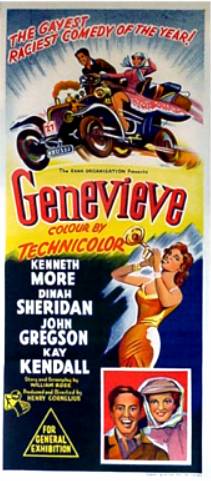 |
For the general release a few months later,
members throughout the country turned out their cars,
and it shortly became apparent that the club was
concerned with a film which appealed to the public as
few had done in recent years. Before long, the film had gone
overseas, and was immediately hailed as a tremendous success.
In the United States it inspired several special "Genevieve" rallies,
and the Horseless Carriage Club of Colorado staged a run for
Veteran cars from Denver to Brighton (Colorado) to coincide with
the film's showing there. They obtained the
regulations of the Brighton Run from the club, and
made every effort to conform to them as closely as
their own circumstances would permit-the essential
differences being a day of brilliant sunshine with a temperature of seventy-six
degrees, and the age limit of the cars, which had to
be 1914 to attract sufficient competitors. The British
Consul for the Rocky Mountain Region, and his wife,
were guests of honour and travelled in a model "T"
Ford. Official greetings were exchanged between the
Mayor of Brighton, Colorado, the Lord Mayor of
Westminster and the Mayor of Brighton, England, and
good wishes between the Presidents of the two clubs.
Every competitor received a special "Genevieve" dashboard plaque and
among the trophies presented was one named after the British club. |
| |
|
| From Australia came news of similar runs in
Adelaide and Sydney, and in Melbourne the film ran
continuously for months. One old lady there attended
every morning performance and after thirteen weeks
became the guest of the management. Nearer home, the
story was the same: in France, Germany and allover the Continent
it has drawn huge crowds, and in Holland it was linked with the
club's rally to Alkmaar, where "Genevieve"
herself, the Darracq which must surely be the most
famed car in the world today, was given a tremendous
welcome of her own. |
| |
|
| There is no doubt that this remarkable film has
carved its own niche in contemporary life, and a
fictitious Brighton Run, with its fantasy and frolic,
has appealed to people all the world over, as has the
genuine article with its unique history. Maybe, the fiction and
the fact bear only a remote resemblance to each other; maybe,
the world's audiences wonder where the one
begins and the other ends. The clue can, perhaps, be
found in Genevieve's own introduction to her public : |
| |
|
For their patient co-operation the makers of
this film express their thanks to the Officers and
Members of The Veteran Car Club of Great Britain.
Any resemblance between the deportment of the
characters and any Club members is emphatically
denied-by the Club.
|
| For his patience, perception and goodwill, Henry
Cornelius is now an honorary member of that club.
Thus, a venture which began as an unknown quantity has
developed into a film of world-wide appeal. In a large measure,
the growth of the club has followed a similar pattern. Slow at first,
it has steadily gathered momentum until its twenty-fifth birthday
witnesses an enthusiasm unimaginable during its first. Started by
three friends, it has grown from a small band to a national and then
international body, and members have come from
all walks of life, from all and sundry trades and
professions to share a common interest and build a
common pride. Now, more than 1,300 of them can
celebrate a Silver Jubilee which has been accomplished by them
all, and rejoicing in the ownership of close on 1,000 cars, can look
forward to a growing entity which, by its very nature, is beyond
time and prediction. |

[Genevieve Home
Page] ["Making Genevieve" Page]
|
